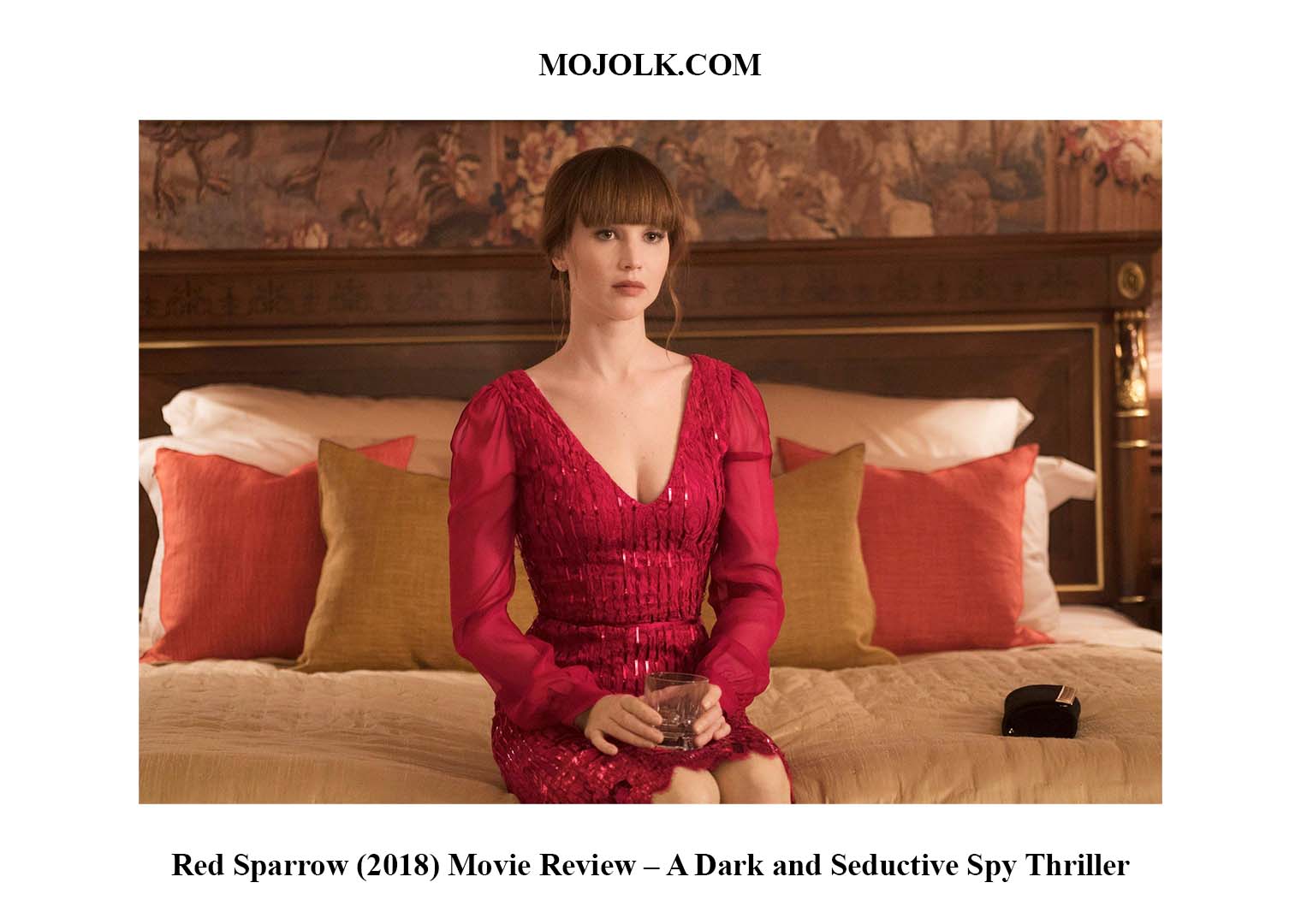Introduction – Why Red Sparrow (2018) Stands Out Among Spy Thrillers
Red Sparrow (2018) delivers a provocative and intense take on the spy thriller genre. Directed by Francis Lawrence, the film stars Jennifer Lawrence as Dominika Egorova, a former Russian ballerina who becomes entangled in the world of espionage. The film explores the psychological toll of betrayal, seduction, and survival within the dangerous world of intelligence. Its dark tone, complex narrative, and standout performances elevate Red Sparrow beyond traditional spy films.
Plot Summary – A Story of Survival and Deception
The story follows Dominika Egorova (Jennifer Lawrence), a talented Russian ballerina whose career ends abruptly after a devastating injury. Facing financial ruin and the threat of losing her mother’s healthcare, Dominika is recruited by her uncle Vanya Egorov (Matthias Schoenaerts) to join the Sparrow School — a brutal Russian intelligence program that trains agents in psychological manipulation and seduction. After enduring harsh training, Dominika is assigned to seduce CIA officer Nate Nash (Joel Edgerton) to uncover the identity of a Russian mole. However, Dominika’s growing connection with Nate challenges her loyalty to Russia, forcing her to navigate a dangerous web of deceit and survival.
Direction – Francis Lawrence’s Intense and Controlled Approach
Francis Lawrence directs Red Sparrow with a sharp focus on psychological tension and emotional complexity. His use of long takes and minimal dialogue heightens the film’s sense of unease. Lawrence balances moments of quiet intensity with sudden bursts of violence, maintaining a controlled and deliberate pace. His ability to depict the harsh training and emotional manipulation within the Sparrow School reflects a deep understanding of espionage tactics. The film’s dark, atmospheric tone enhances the underlying sense of paranoia and vulnerability.
Acting – Jennifer Lawrence’s Career-Defining Role
Jennifer Lawrence delivers a powerful performance as Dominika Egorova. She captures Dominika’s transformation from vulnerable ballerina to calculating spy with emotional depth and physical intensity. Lawrence’s commitment to the role included learning ballet and mastering a Russian accent, adding authenticity to her performance. Joel Edgerton portrays Nate Nash with subtle charm and moral conflict, providing a grounded contrast to Lawrence’s intense portrayal. Matthias Schoenaerts brings menace and authority to the role of Vanya Egorov, while Charlotte Rampling’s icy demeanor as the Sparrow School’s matron adds psychological weight to the film.
Themes and Symbolism – Power, Manipulation, and Betrayal
Red Sparrow explores the complex relationship between power, seduction, and survival. Dominika’s training at the Sparrow School forces her to use her body and mind as weapons, reflecting the psychological toll of espionage. The film contrasts vulnerability and strength, showing how Dominika reclaims control over her fate through calculated manipulation. The use of cold, sterile environments symbolizes the emotional detachment and moral ambiguity within the world of intelligence. The film’s exploration of loyalty and betrayal underscores the personal cost of living a double life.
Performance Review – How Lawrence and Edgerton Elevate the Film
Jennifer Lawrence’s performance anchors the film’s emotional core. Her portrayal of Dominika’s internal struggle and strategic manipulation adds depth to the character. Edgerton’s portrayal of Nate Nash provides emotional balance, highlighting the ethical conflict within the intelligence community. Matthias Schoenaerts’ portrayal of Vanya Egorov exudes cold calculation and psychological dominance. Charlotte Rampling’s understated performance as the Sparrow School matron reinforces the film’s exploration of emotional control and obedience.
Cinematography – Cold War Aesthetics and Dark Tones
Jo Willems’ cinematography reflects the film’s bleak and oppressive atmosphere. The use of cold color palettes and shadowed lighting enhances the emotional weight of Dominika’s journey. The film’s visual style contrasts sterile training facilities with opulent diplomatic settings, highlighting the intersection of power and vulnerability. The camera’s focus on Lawrence’s expressions and body language heightens the psychological tension. Willems’ framing of key scenes emphasizes Dominika’s emotional and strategic control over her surroundings.
Storyline – Why Red Sparrow (2018) Stands Out in the Spy Genre
The film’s narrative blends traditional espionage elements with psychological complexity. Dominika’s character arc follows her transformation from victim to manipulator, challenging the typical spy film trope of the “femme fatale.” Francis Lawrence’s decision to focus on psychological manipulation rather than high-tech gadgetry distinguishes the film from other espionage thrillers. The emotional connection between Dominika and Nate adds emotional stakes to the story’s political and strategic conflicts. The film’s unpredictable twists and moral ambiguity keep viewers engaged.
True Story – How Red Sparrow (2018) Draws From Real Intelligence Practices
Red Sparrow is based on the novel by Jason Matthews, a former CIA operative. Matthews’ experience in intelligence work informs the film’s realistic depiction of spy tactics and psychological manipulation. The Sparrow School reflects real-life “honey trap” operations used by Russian intelligence to extract information through seduction. While the film takes creative liberties, its exploration of loyalty, betrayal, and survival reflects the real-life complexity of espionage.
Controversy – Mixed Reactions to the Film’s Graphic Content
Red Sparrow sparked debate for its graphic violence, sexual content, and depiction of psychological abuse. Some critics praised the film’s fearless approach to exploring the darker side of espionage. Others argued that the film’s explicit content detracted from the narrative’s emotional impact. Jennifer Lawrence’s willingness to portray vulnerability and strength in the face of exploitation became a focal point of both praise and criticism. Despite the divided reception, the film’s exploration of power dynamics and survival resonated with many viewers.
Cultural Impact – How Red Sparrow Influenced Modern Spy Thrillers
Red Sparrow challenged the traditional portrayal of female spies in Hollywood. Dominika’s character subverts the “femme fatale” stereotype by reclaiming agency and control over her body and decisions. The film’s exploration of psychological manipulation influenced other spy thrillers and female-led action films. Jennifer Lawrence’s performance reinforced her versatility as an actress, while Francis Lawrence’s direction highlighted the emotional and moral complexities of espionage.
Conclusion – Why Red Sparrow Remains a Bold and Unforgettable Spy Thriller
Red Sparrow (2018) stands out as a dark and thought-provoking entry in the spy thriller genre. Jennifer Lawrence’s emotionally raw and physically intense performance anchors the film’s exploration of power, betrayal, and survival. Francis Lawrence’s direction and Jo Willems’ cinematography create a cold and oppressive atmosphere that enhances the film’s psychological depth. For viewers seeking a spy film that prioritizes emotional complexity over high-tech action, Red Sparrow delivers a gripping and unforgettable experience.

